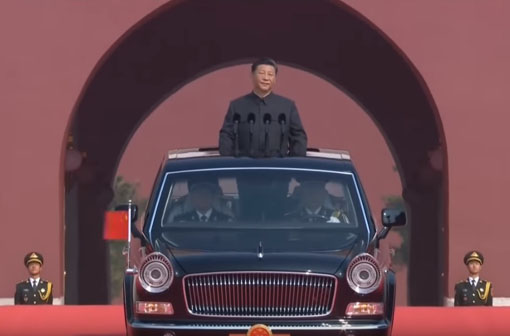by WorldTribune Staff, October 1, 2019
Dressed in a grey jacket reminiscent of the style of his murderous hero Mao Zedong, supreme leader Xi Jinping presided over a massive military parade on Oct. 1 to mark the 70th anniversary of the Chinese Communist Party’s founding. Like Mao, Xi has amassed enormous political power and is in effect president for life.
“No force can ever shake the status of China, or stop the Chinese people and nation from marching forward,” Xi said as he inspected an event which featured 15,000 troops and more than 160 aircraft and displayed some of the communist state’s most formidable new firepower.

China displayed its new Dongfeng 41 intercontinental ballistic missile (ICBM), which is believed to be one of the most powerful nuclear weapons in the world.
Analysts believe DF-41 is capable of hitting anywhere in the United States and can strike targets within just 30 minutes of being fired with 10 nuclear warheads that are capable of striking multiple targets simultaneously.
Related: On eve of Chinese Communists’ 70th year in power, Hong Kong activist warns Taiwan, September 30, 2019
Also unveiled for the first time was the Dongfeng-17, a hypersonic nuclear missile that is also thought to carry multiple warheads, fly faster than conventional weapons to evade defense systems, and at a lower altitude to avoid detection before impact.
While not mentioning Taiwan by name, Xi also spoke of a “complete reunification” of China and “stability in Hong Kong”.
“On our journey forward, we must uphold the principles of peaceful reunification and one country, two systems; maintain lasting prosperity and stability in Hong Kong and Macau … and continue to strive for the motherland’s complete reunification,” Xi said in a speech which was nationally televised.
The event marks the anniversary of the Oct. 1, 1949, announcement of the founding of the People’s Republic of China by then-leader Mao Zedong following a civil war.
According to the “Black Book of Communism,” an estimated 65 million Chinese died as a result of Mao’s repeated, merciless attempts to create a new “socialist” China, making him by extension the most prolific mass murderer of the 20th Century.
Meanwhile, in Hong Kong on Oct. 1, police fired tear gas and rubber bullets at pro-democracy protesters, The Associated Press reported.
The South China Morning Post and television reports said at least one person was wounded in the chest by police firing live rounds. Police did not respond to requests for comment but have said they fired live rounds into the air in previous clashes.
Video footage of a police officer firing at a protester at close range went viral, but there was no immediate verification of its authenticity.
Fifteen people were wounded across the territory, one critically, the Hospital Authority said without giving details.
“Protesters had vowed to seize the opportunity on China’s National Day to propel their calls for greater democracy onto the international stage, hijacking an occasion Beijing sees as an opportunity to showcase China’s economic and military progress,” the AP report said.
A 42-year-old pro-democracy protester told AP: “I’m not young, but if we don’t march now, we’ll never have the chance to speak again, it’s as simple as that.”
Intelligence Brief __________ Replace The Media
